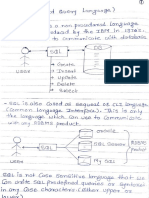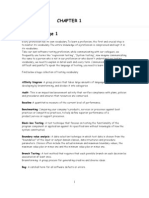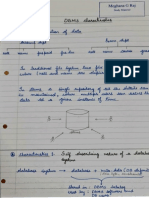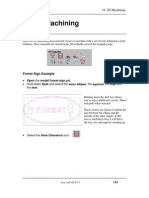Cheat Sheet Postgresql
Uploaded by
yagaCheat Sheet Postgresql
Uploaded by
yagaPostgreSQL Cheat Sheet
www.databasestar.com
SELECT Query Modifying Data Create Table
SELECT col1, col2
FROM table Insert INSERT INTO tablename Create Table CREATE TABLE tablename (
JOIN table2 ON table1.col = table2.col (col1, col2...) column_name data_type
WHERE condition VALUES (val1, val2); );
GROUP BY column_name Insert from a
HAVING condition INSERT INTO tablename
Table
ORDER BY col1 ASC|DESC; (col1, col2...) Create Table with Constraints
SELECT col1, col2...
CREATE TABLE tablename (
SELECT Keywords Insert Multiple
Rows
INSERT INTO tablename
(col1, col2...) VALUES column_name data_type NOT NULL,
(valA1, valB1), CONSTRAINT pkname PRIMARY KEY (col),
DISTINCT: Removes SELECT DISTINCT product_name (valA2, valB2), CONSTRAINT fkname FOREIGN KEY (col)
duplicate results FROM product; (valA3, valB3); REFERENCES other_table(col_in_other_table),
CONSTRAINT ucname UNIQUE (col),
CONSTRAINT ckname CHECK (conditions)
BETWEEN: Matches a SELECT product_name
Update UPDATE tablename );
value between two FROM product
other values (inclusive) WHERE price BETWEEN 50 AND 100; SET col1 = val1
WHERE condition;
Create Temporary CREATE TEMP TABLE tablename (
SELECT product_name Table colname datatype
IN: Matches to any of
FROM product Update with UPDATE t );
the values in a list
WHERE category IN a Join SET col1 = val1
('Electronics', 'Furniture'); FROM tablename t
INNER JOIN table x Drop Table DROP TABLE tablename;
LIKE: Performs SELECT product_name ON t.id = x.tid
wildcard matches using FROM product WHERE condition;
_ or % WHERE product_name
Delete DELETE FROM tablename
Alter Table
LIKE '%Desk%";
WHERE condition;
Add Column ALTER TABLE tablename ADD COLUMN
columnname datatype;
Joins Indexes
Drop Column ALTER TABLE tablename DROP COLUMN
Create Index CREATE INDEX indexname columnname;
SELECT t1.*, t2.*
ON tablename (cols);
FROM t1
join_type t2 ON t1.col = t2.col; Modify Column ALTER TABLE tablename ALTER COLUMN
Drop Index DROP INDEX indexname; columnname TYPE newdatatype;
Table 1 Table 2
A A
Set Operators Rename Column ALTER TABLE tablename RENAME COLUMN
currentname TO newname;
B B
C D UNION: Shows unique
Add Constraint ALTER TABLE tablename ADD CONSTRAINT
rows from two result sets. constraintname constrainttype
INNER JOIN: show all matching A (columns);
A
records in both tables. UNION ALL: Shows all
B B
rows from two result sets.
Drop Constraint ALTER TABLE tablename DROP
constraint_type constraintname;
LEFT JOIN: show all records from left A A
INTERSECT: Shows rows that
table, and any matching records from Rename Table ALTER TABLE tablename
B B exist in both result sets.
right table. RENAME TO newtablename;
C
EXCEPT: Shows rows that exist
RIGHT JOIN: show all records from in the first result set but not
Window/Analytic Functions
A A
right table, and any matching records the second.
B B
from left table.
function_name ( arguments ) OVER (
Aggregate Functions
D
[query_partition_clause]
[ORDER BY order_by_clause
FULL JOIN: show all records from A A SUM: Finds a total of the numbers provided
[windowing_clause] ] )
both tables, whether there is a match COUNT: Finds the number of records
or not. B B AVG: Finds the average of the numbers provided
Example using RANK, showing the student details and their rank
C MIN: Finds the lowest of the numbers provided
according to the fees_paid, grouped by gender:
MAX: Finds the highest of the numbers provided
D
SELECT
Common Functions
student_id, first_name, last_name, gender, fees_paid,
CASE Statement
RANK() OVER (
LENGTH(string): Returns the length of the provided string PARTITION BY gender ORDER BY fees_paid
POSITION(string IN substring): Returns the position of the ) AS rank_val
Simple Case CASE name FROM student;
substring within the specified string.
WHEN 'John' THEN 'Name John'
CAST(expression AS datatype): Converts an expression into the
WHEN 'Steve' THEN 'Name Steve'
specified data type.
ELSE 'Unknown'
END
NOW: Returns the current date, including time.
CEIL(input_val): Returns the smallest integer greater than the
Subqueries
provided number. SELECT id, last_name, salary
Single Row
Searched Case CASE FLOOR(input_val): Returns the largest integer less than the FROM employee
WHEN name='John' THEN 'Name John' provided number. WHERE salary = (
WHEN name='Steve' THEN 'Name Steve' ROUND(input_val, [round_to]): Rounds a number to a specified SELECT MAX(salary)
ELSE 'Unknown' number of decimal places. FROM employee
END TRUNC(input_value, num_decimals): Truncates a number to a );
number of decimals.
Common Table Expression SELECT id, last_name, salary
REPLACE(whole_string, string_to_replace, replacement_string): Multi Row
Replaces one string inside the whole string with another string. FROM employee
SUBSTRING(string, [start_pos], [length]): Returns part of a value, WHERE salary IN (
WITH queryname AS ( based on a position and length. SELECT salary
SELECT col1, col2 FROM employee
FROM firsttable) WHERE last_name LIKE 'C%'
SELECT col1, col2.. );
FROM queryname...;
You might also like
- Aprilia RSV Mille 1999 Manual de Reparatie WWW - Manualedereparatie.infoNo ratings yetAprilia RSV Mille 1999 Manual de Reparatie WWW - Manualedereparatie.info279 pages
- Introduction To RDBMS Participant GuideNo ratings yetIntroduction To RDBMS Participant Guide182 pages
- My) SQL Cheat Sheet: Mysql Command-Line What How Example (S)No ratings yetMy) SQL Cheat Sheet: Mysql Command-Line What How Example (S)3 pages
- Q1. What Is The Difference Between SQL and Mysql?No ratings yetQ1. What Is The Difference Between SQL and Mysql?37 pages
- PostgreSQL Cheat Sheet & Quick ReferenceNo ratings yetPostgreSQL Cheat Sheet & Quick Reference5 pages
- Google Cloud Computing Foundations M2 - Start With A Solid Platform v3No ratings yetGoogle Cloud Computing Foundations M2 - Start With A Solid Platform v357 pages
- A Simple CRUD Tutorial Using Java ServletNo ratings yetA Simple CRUD Tutorial Using Java Servlet18 pages
- 07 - Ingesting New Datasets Into Google BigQueryNo ratings yet07 - Ingesting New Datasets Into Google BigQuery8 pages
- List of Experiments: Exp No. Title Prerequisite Course OutcomeNo ratings yetList of Experiments: Exp No. Title Prerequisite Course Outcome58 pages
- Basic Linux Commands For Linux Terminal Beginners - PCsteps100% (1)Basic Linux Commands For Linux Terminal Beginners - PCsteps19 pages
- Spnego Single Sign-On Using Secure Login Server X.509 Client CertificatesNo ratings yetSpnego Single Sign-On Using Secure Login Server X.509 Client Certificates25 pages
- Laravel Development Using Phpstorm: Prerequisites (Plugin Installation and Configuration)No ratings yetLaravel Development Using Phpstorm: Prerequisites (Plugin Installation and Configuration)18 pages
- Vagrant: Configuration Virtual EnvironmentsNo ratings yetVagrant: Configuration Virtual Environments10 pages
- Question 1: Introduction To SQL. Explain What Are Different Types of Data Types in SQLNo ratings yetQuestion 1: Introduction To SQL. Explain What Are Different Types of Data Types in SQL39 pages
- [Ebooks PDF] download Scripting Automation with Bash PowerShell and Python 1st Edition Michael Kofler full chapters92% (12)[Ebooks PDF] download Scripting Automation with Bash PowerShell and Python 1st Edition Michael Kofler full chapters60 pages
- Oracle Data Integrator Expression TransformationNo ratings yetOracle Data Integrator Expression Transformation20 pages
- Codex Standard For Pickled Cucumbers (Cucumber Pickles) CODEX STAN 115-1981No ratings yetCodex Standard For Pickled Cucumbers (Cucumber Pickles) CODEX STAN 115-198111 pages
- Department of Education: Laura de Leon Halili High SchoolNo ratings yetDepartment of Education: Laura de Leon Halili High School2 pages
- BM SI 4G Project Introduction of Solution and DeliveryNo ratings yetBM SI 4G Project Introduction of Solution and Delivery22 pages
- PDF Sound Intensity Second Edition Frank J. Fahy download100% (1)PDF Sound Intensity Second Edition Frank J. Fahy download81 pages
- Get Successful Project Management 7th Edition Gido Test Bank free all chapters100% (9)Get Successful Project Management 7th Edition Gido Test Bank free all chapters58 pages
- Instant Download (eBook PDF) Linear System Theory and Design 4th Edition PDF All Chapters100% (5)Instant Download (eBook PDF) Linear System Theory and Design 4th Edition PDF All Chapters41 pages
- Walmart - Sales: Pandas PD Seaborn Sns Numpy NP Matplotlib - Pyplot PLT Matplotlib Datetime100% (1)Walmart - Sales: Pandas PD Seaborn Sns Numpy NP Matplotlib - Pyplot PLT Matplotlib Datetime26 pages
























































































